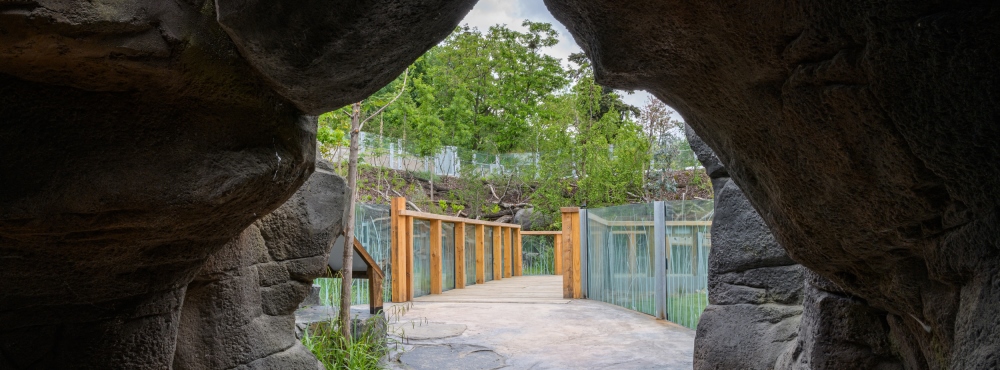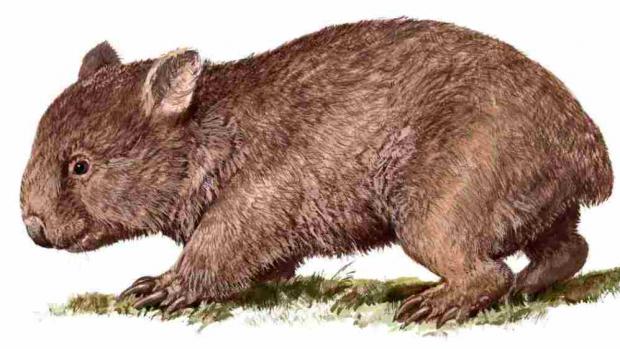A creature with an international name

Say “wombat” and people will understand you almost anywhere in the world. This marsupial dislikes heat, leads a solitary life, and spends at least half of its time in burrows—often having several within its territory. These underground shelters even allow it to survive devastating Australian bushfires. Prague Zoo welcomed its first common wombats in 2021.
 Common wombat. Illustration: Pavel Procházka
Common wombat. Illustration: Pavel Procházka
With their sturdy, stocky bodies, short powerful legs, massive claws, broad flat heads, widely spaced eyes, short necks and virtually invisible tails, wombats have a truly distinctive appearance. Interestingly, in nearly every language they are known by the same name, which comes from the language of the Darug people, the original inhabitants of the area around present-day Sydney.
FROM THE SE TO THE SNOWLINE
There are three known species of wombat today: the southern hairy-nosed wombat, the northern hairy-nosed wombat, and the common wombat. They are found in southeastern Australia, Tasmania, and some Bass Strait islands. Their closest living relative is the koala.
Wombats possess several unique traits that are rare or absent in other marsupials. Uniquely among marsupials, they have incisors that resemble those of rodents. Each jaw has a single pair, and their teeth grow continuously throughout life, ground down by the tough vegetation they consume. A feature shared with koalas is the backward-facing pouch, which is a vital adaptation for digging: as the mother excavates soil behind her, she doesn’t risk filling her pouch with dirt.
Human activity has severely restricted the habitat available to all three wombat species. While the common wombat remains the most widespread, some populations and subspecies are considered threatened. Key dangers include collisions with vehicles, agricultural conflicts (despite being protected in most Australian states, they are still viewed by some landowners as pests), or poisoning from toxins aimed at invasive rabbits. Roaming dogs, and diseases such as sarcoptic mange are also a threat.
Hairy-nosed wombats typically live in more arid habitats, whereas the common wombat inhabits more humid environments—from cool, wet forests in the north of its range to sclerophyll woodlands, shrublands and heathlands, always requiring access to nearby pasture. In mountainous areas, the common wombat is uniquely adapted to remain active even above the snowline in winter, digging through snow up to a metre deep to find food. Its diet includes a range of grasses, sedges and rushes—usually fibrous and coarse species high in cellulose. It does not thrive on livestock pasture grasses and prefers areas maintained by native grazers such as kangaroos. Some invasive plant species that colonise abandoned cattle pastures are toxic or inedible to wombats.
CUBES DON´T ROLL
Living in more humid environments than its hairy-nosed cousins, the common wombat doesn’t need to conserve water as strictly. This has two consequences. Firstly, its burrows tend to be simpler in structure, and it leads a more solitary lifestyle. Its tunnels—usually dug into slopes—sometimes have a second entrance, and the nesting chamber is lined with leaves, twigs and bark.
Secondly, it produces moister faeces, which are less often in the iconic cube shape seen in other wombat species. For a long time, the cubed shape of wombat droppings puzzled researchers, until it was recently explained as a result of differing elasticity in the intestinal wall. Wombats mark their territory by depositing faeces on raised surfaces like rocks and logs, and cube shapes don’t roll away like round ones do. Common wombats also use their droppings to mark trails, burrows, and even newly introduced objects. They often rub against these objects—possibly to mark territory, remove parasites, or simply because it feels good. Every day begins with the wombat emerging from its burrow, rolling in dust and having a good scratch.
UP TO TWENTY YEARS OF LIFE
Wombats usually breed during the Australian spring and summer (October to January), which is also the only time males and females come into contact. At other times, they may chase and bite each other when meeting. Before mating—which occurs inside burrows—the pair engages in a ritual of chasing and circling. After mating, the male takes no further part in rearing the young. The tiny joey is born after a short gestation of about three weeks and makes its own way into the mother’s pouch. Around five months later, it begins peeking out while the mother grazes—the joey faces backwards and nibbles grass from the pouch. It emerges for the first time at about seven months and leaves the pouch for good at ten. It continues to suckle and stay close to the mother until around 18 months. As a result, females typically breed only once every two years. Weaning is a critical phase in the young wombat’s life and usually coincides with the time of greatest plant growth. Wombats reach maturity at 2–3 years and can live for 15 to 20 years in the wild.
ZOOPRAHA.CZ
Contacts
- The Prague zoological garden
U Trojskeho zamku 120/3
171 00 Praha 7
Phone.: (+420) 296 112 230 (public relations department)
e-mail: zoopraha@zoopraha.cz
Others








